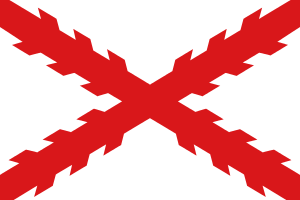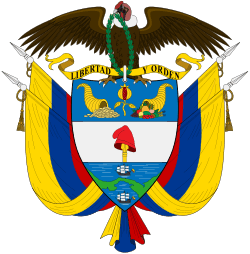New Kingdom of Granada
| New Kingdom of Granada Kingdom of the New Granada | ||||||||
| Nuevo Reino de Granada Reino de la Nueva Granada | ||||||||
| Colony of the Spanish Empire | ||||||||
| ||||||||
 Burgundian Saltire
.svg.png) Coat of arms of Bogotá
| ||||||||
 The New Kingdom of Granada | ||||||||
| Capital | Santa Fe de Bogotá | |||||||
| Languages | Castilian | |||||||
| Religion | Roman Catholic | |||||||
| Government | Monarchy | |||||||
| King | Kings of Spain | |||||||
| Viceroy | Viceroys of New Granada | |||||||
| Historical era | Spanish colonization of the Americas | |||||||
| • | Established | 16th century | ||||||
| • | Viceroyalty established. | July 17, 1712 | ||||||
| • | Viceroyalty suppressed; kingdom autonomous again | November 5, 1723 | ||||||
| • | Disestablished | August 20, 1739 | ||||||
| Currency | Real | |||||||
| ||||||||
| Today part of | | |||||||
Part of a series on the |
||||||||||||||||||||
|---|---|---|---|---|---|---|---|---|---|---|---|---|---|---|---|---|---|---|---|---|
| History of Colombia | ||||||||||||||||||||
 | ||||||||||||||||||||
| Timeline | ||||||||||||||||||||
|
||||||||||||||||||||
|
| ||||||||||||||||||||
The New Kingdom of Granada (Spanish: Nuevo Reino de Granada), or Kingdom of the New Granada, was the name given to a group of 16th-century Spanish colonial provinces in northern South America governed by the president of the Audiencia of Santa Fe, an area corresponding mainly to modern-day Colombia, Panama and Venezuela. The conquistadors originally organized it as a captaincy general within the Viceroyalty of Peru. The crown established the audiencia in 1549. Ultimately the kingdom became part of the Viceroyalty of New Granada first in 1717 and permanently in 1739. After several attempts to set up independent states in the 1810s, the kingdom and the viceroyalty ceased to exist altogether in 1819 with the establishment of Gran Colombia.[1]
History

Discovery and settlement
In 1514, the Spanish first permanently settled in the area. With Santa Marta (founded on July 29, 1525 by the Spanish conquistador Rodrigo de Bastidas) and Cartagena (1533), Spanish control of the coast was established, and the extension of colonial control into the interior could begin. Starting in 1536, the conquistador Gonzalo Jiménez de Quesada explored the extensive highlands of the interior of the region, by following the Magdalena River into the Andean cordillera. There his force defeated the powerful Muisca and founding the city of Santa Fé de Bogotá (c. 1538, currently Bogotá) and naming the region El nuevo reino de Granada, "the new kingdom of Granada", in honor of the last part of Spain to be recaptured from the Moors, home to the brothers De Quesada. After Gonzalo Jiménez de Quesada left for Spain in May 1539, the reign of the colony was transferred to his brother Hernán. De Quesada, however, lost control of the province when Emperor Charles V granted the right to rule over the area to rival conquistador, Sebastián de Belalcázar, in 1540, who had entered the region from what is today Ecuador, and named himself governor of Popayán.
Regularization of the government
Belalcázar's victory placed the region under the Viceroyalty of Peru, which was being organized at the time. Charles V ordered the establishment of an audiencia, a type of superior court that combined executive and judicial authority, at Santa Fé de Bogotá in 1549.
List of governors
| Start | End | Governor |
|---|---|---|
| 1538 | 1539 | Gonzalo Jiménez de Quesada |
| 1539 | 1542 | Hernán Pérez de Quesada |
| 1542 | 1544 | Alonso Luis Fernández de Lugo |
| 1544 | 1545 | Lope Montalvo de Lugo |
| 1545 | 1546 | Pedro de Ursúa |
| 1546 | 1550 | Miguel Díez de Armendáriz |
| 1551 | 1558 | Juan de Montaño |
Royal Audiencia
The Royal Audiencia was created by a royal decree of July 17, 1549. It was given authority over the provinces of Santa Marta, Río de San Juan, Popayán, Guayana and Cartagena de Indias. The Audiencia was charged primarily with dispensing justice, but it was also to oversee the running of government and the settlement of the territory. It held its first session on April 7, 1550, in a mansion on the Plaza Mayor (today, Plaza de Bolívar) at the site which today houses the Colombian Palace of Justice.
Initially all of the justices held executive power. After several royal inspectors (visitadores) sent to improve the audiencia's functioning, in 1564 executive power was centralized in one officer, the Audiencia "president", who was also made governor and captain general. (For this reason the region was also referred to as a presidencia at the time.) With these two offices the president oversaw the civilian government and held the command over the kingdom's military forces. The president was loosely dependent upon the Viceroy of Peru at Lima in administrative and military matters. The jurisdictional boundaries of the Audiencia encompassed the territory of the kingdom.
Law VIII ("Royal Audiencia and Chancery of Santa Fe in the New Kingdom of Granada") of Title XV ("Of the Royal Audiencias and Chanceries of the Indies") of Book II of the Recopilación de Leyes de las Indias of 1680—which compiles the decrees of July 17, 1549; May 10, 1554; and August 1, 1572—describes the final limits and functions of the Audiencia.[2]
In Santa Fé de Bogotá of the New Kingdom of Granada shall reside another Royal Audiencia and Chancery of ours, with a president, governor and captain general; five judges of civil cases [oidores], who shall also be judges of criminal cases [alcaldes del crimen]; a crown attorney [fiscal]; a bailiff [alguacil mayor]; a lieutenant of the Gran Chancellor; and the other necessary ministers and officials, and which will have for district the provinces of the New Kingdom and those of Santa Marta, Río de San Juan, and of Popayán, except those places of the latter which are marked for the Royal Audiencia of Quito; and of Guayana, or El Dorado, it shall have that which is not of the Audienicia of Hispaniola, and all of the Province of Cartagena; sharing borders: on the south with said Audiencia of Quito and the undiscovered lands, on the west and north with the North Sea and the provinces which belong to the Royal Audiencia of Hispaniola, on the west with the one of Tierra Firme. And we order that the Governor and Captain General of said provinces and president of their Royal Audiencia, have, use and exercise by himself the government of all the district of that Audiencia, in the same manner as our Viceroys of New Spain and appoint the repartimiento of Indians and other offices that need to be appointed, and attend to all the matters and business that belong to the government, and that the oidores of said Audiencia do not interfere with this, and that all sign what in matters of justice is provided for, sentenced and carried out.
One further change came as part of the Bourbon Reforms of the eighteenth century. Because of the slowness in communications between Lima and Bogotá, the Bourbons decided to establish an independent Viceroyalty of New Granada in 1717 (which was reestablished in 1739 after a short interruption). The governor-president of Bogotá became the viceroy of the new entity, with military and executive oversight over the neighboring Presidency of Quito and the provinces of Venezuela.
Administrative divisions
The New Kingdom was organized into several Governments and Provinces:
| Government/Province | Capital | Established | Founder |
|---|---|---|---|
| Government of Santa Marta | Santa Marta | 1525 | Don Rodrigo de Bastidas |
| Government of Cartagena de Indias | Cartagena de Indias (Alternative Capital of Viceroyalty) | 1533 | Don Pedro de Heredia |
| Government of Popayán | Popayán | 1537 | Don Sebastián de Belalcázar |
| Province of Pasto | San Juan de Pasto | 1539 | Don Lorenzo de Aldana |
| Government of Santa Fé (de Bogotá), the area originally called the "New Kingdom of Granada" | Santa Fé de Bogotá (Capital of Viceroyalty) | 1538 | Don Gonzalo Jiménez de Quesada |
| Government of Tunja | Tunja | 1539 | Don Gonzalo Suárez Rendón |
| Government of Antioquia | Santa Fe de Antioquia | 1541 | Don Jorge Robledo |
| Province of Chocó | Quibdó | 1648 | Manuel Cañizales |
| Government of Panama | Ciudad de Panama | 1519 | Don Pedro Arias Dávila |
| Vast Province of Guyana (special province) | Angostura | 1595 | Don Antonio de Berríos |
Main cities
The largest cities of the New Kingdom of Granada in the 1791 Census were
- Cartagena de Indias – 154,304
- Santa Fé de Bogotá – 108,533
- Popayan – 56,783
- Santa Marta – 49,830
- Tunja – 43,850
- Mompóx – 24,332
See also
Bibliography
- Avellaneda Navas, José Ignacio. The Conquerors of the New Kingdom of Granada ((Albuquerque): University of New Mexico Press, 1995)
- Cook, Karoline P. "Religious Identity, Race and Status in New Granada." Race and Blood in the Iberian World; 3 (2012): 81.
- Fisher, John R., Allan J. Keuthe, and Anthony McFarlane, eds. Reform and Insurrection in Bourbon New Granada and Peru. Baton Rouge: Louisiana State University Press, 1990. ISBN 978-0-8071-1654-8
- Graff, Gary W. "Spanish Parishes in Colonial New Granada: Their Role in Town-Building on the Spanish-American Frontier." The Americas (1976): 336-351. [ in JSTOR]
- Grahn, Lance Raymond. The Political Economy of Smuggling: regional informal economies in early Bourbon New Granada (Boulder: Westview Press, 1997)
- Kuethe, Allan J. Military Reform and Society in New Granada, 1773–1808. Gainesville: University Presses of Florida, 1978. ISBN 978-0-8130-0570-6
- Markham, Clements. The Conquest of New Granada (1912) online
- McFarlane, Anthony. Colombia Before Independence: Economy, Society and Politics under Bourbon Rule. Cambridge: Cambridge University Press, 1993. ISBN 978-0-521-41641-2
- Phelan, John Leddy. The People and the King: The Comunero Revolution in Colombia, 1781. Madison: University of Wisconsin Press, 1978. ISBN 978-0-299-07290-2
- Ramírez, Susan Elizabeth. "Institutions of the Spanish American Empire in the Hapsburg Era." in A Companion to Latin American History (2008): 106-23.
- Rodríguez Freyle, Juan. The Conquest of New Granada (London: Folio Society, 1961)
References
- ↑ Avellaneda Navas and José Ignacio. The conquerors of the New Kingdom of Granada ((Albuquerque): University of New Mexico Press, 1995)
- ↑ Spain (1680). Recopilación de las Leyes de Indias. Titulo Quince. De las Audiencias y Chancillerias Reales de las Indias. Madrid. Spanish-language facsimile of the original.
External links
| Wikimedia Commons has media related to Spanish colonial period in Colombia. |
- The Educated Vassal in the State of the New Kingdom of Granada, and His Respective Duties — written 1789.